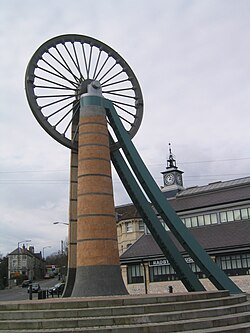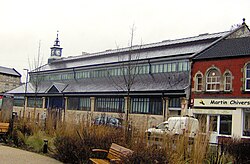Radstock
| Radstock | |
| Somerset | |
|---|---|
 The old winding wheel in front of Radstock Museum | |
| Location | |
| Grid reference: | ST688549 |
| Location: | 51°17’34"N, 2°26’52"W |
| Data | |
| Population: | 5,620 (2011) |
| Post town: | Radstock |
| Postcode: | BA3 |
| Dialling code: | 01761 |
| Local Government | |
| Council: | Bath & NE Somerset |
| Parliamentary constituency: |
North East Somerset |
Radstock is a village in Somerset, nine miles south-west of Bath, and eight miles north-west of Frome. A sizable village, it had a recorded population of 5,620 at the 2011 Census.
Traces of settlement in Radstock have been found as far back as the Iron Age, and its importance of the site grew after the construction of the Fosse Way, a Roman road. The growth of the town occurred after 1763, when coal was discovered in the area. Large numbers of mines opened during the 19th century including several owned by the Waldegrave family, who had been Lords of the Manor since the Civil War. Admiral Lord Radstock, brother of George, fourth Earl Waldegrave, took the town's name as his title when created a Baron.
Mining has since ceased but its legacy is visible in and around the village. Radstock today has increasingly become a commuter town for the nearby cities of Bath and Bristol. It is known for its museum and for Writhlington School (famous for its orchid collection). It has a range of churches and schools and cultural and sporting clubs.
Coal and industry
The spoil heap of Writhlington colliery is now the Writhlington Site of Special Scientific Interest, which includes 3,000 tons of Upper Carboniferous spoil from which more than 1,400 insect fossil specimens have been recovered.
In 1763, coal was discovered in Radstock and mining began in the area.[1] In, 1896 the pits were owned by the Trustee of Frances, late Countess of Waldegrave.[2] The Waldegrave family had been Lords of the Manor of Radstock since the Civil War. Between 1800 and 1850, Ludlows, Middle Pit, Old Pit, Smallcombe, Tynings, and Wellsway mines opened. There were also a series of pits east of the town at Writhlington and under different ownership.
The complex geology and narrow seams made coal extraction difficult. Tonnage increased throughout the 19th century, reaching a peak around 1901, when there were 79 separate collieries and annual production was 1,250,000 tons a year. However, due to local geological difficulties and manpower shortages output declined and the number of pits reduced from 30 at the beginning of the 20th century to 14 by the mid-thirties; the last two pits, Kilmersdon and Writhlington, closed in September 1973. The Great Western Railway and the Somerset and Dorset Railway both established stations and marshalling yards in the town. The last passenger train services to Radstock closed in 1966. Manufacturing industries such as printing, binding and packaging provide some local employment.
The Radstock Museum is housed in a former market hall, and has a range of exhibits which offer an insight into life in north-eastern Somerset life since the 19th century. Many of the exhibits relate to local geology and the now disused Somerset coalfield and geology.
History
The village which became Radstock grew in importance with the construction of the Fosse Way, the Roman road that ran along what is now part of the A367 in Radstock.
In the Domesday Book of 1086 it is listed as Stoche, from the Old English "stocc indicating a stockade farm. The rad part of the name is believed to be the Old English read', meaning 'red'; a reference to the local soil which is reddish marl.[3]
The Great Western Railway, and the Somerset and Dorset Railway, established stations and marshalling yards in the town. Radstock was the terminus for the southern branch of the Somerset Coal Canal, which was turned into a tramway in 1815.[4] It then became a central point for railway development, with large coal depots, wash houses, workshops and a gas works. As part of the development of the Wiltshire, Somerset and Weymouth Railway, an eight-mile line from Radstock to Frome was built to carry the coal. In the 1870s the broad-gauge line was converted to standard gauge and connected to the Bristol and North Somerset Line which linked the town to the Great Western Railway.
The Radstock Railway Land covers the old marshalling yards and sheds and comprises an area of approximately 22 acres of land which is the subject of ongoing planning and development applications to redevelop the area.
On 7 August 1876 the Radstock rail accident befell: a rail crash on the Somerset and Dorset Joint Railway in which wo trains collided on a single track section, resulting in the deaths of 15 passengers.[5]
The last passenger train services in Radstock closed in 1966, and the last coal mines closed in 1973. Manufacturing industries have continued however..
Geography
The main geological feature in this area of the Mendip Hills south of Hallatrow consists of Supra-Pennant Measures which includes the upper coal measures and outcrops of sandstone.[6] The southern part of the Radstock Syncline have coals of the Lower and Middle Coal Measures been worked, mainly at the Newbury and Vobster collieries in the southeast and in the New Rock and Moorewood pits to the southwest.[7]
The Hercynian orogeny caused shock waves in the rock as the Mendip Hills were pushed up, forcing the coal measures to break along fractures or faults. Along the Radstock Slide Fault the distance between the broken ends of a coal seam can be as much as 1,500 feet.[8]
Radstock lies on the Wellow Brook which then runs through Wellow to join the Cam Brook at Midford to form Midford Brook before joining the River Avon close to the Dundas Aqueduct and the remains of the Somerset Coal Canal. The base of the valley is of alluvium deposits. Above this on both sides of all of the valley is a band of shales and clays from the Penarth Group. These rocks are from the Triassic period. The majority of the remaining upland around Radstock is Lias Group|Lias Limestone (white and blue) while the very highest part, south of Haydon, is a small outcrop of Inferior Oolitic Limestone.
Below all of the area is the coal bearing Carboniferous strata. Haydon is an outlier of Radstock and was built to house the miners for the local pit. The disused railway line and inclined railway at Haydon form important elements within the Kilmersdon valley east of Haydon. The modern landscape has a less maintained and rougher character and texture than neighbouring agricultural areas. This is caused in the main by the remnants of the coal industry and its infrastructure and changes in agricultural management. The disturbance caused by coal mining and the railways and the subsequent ending of mining and disuse of the railways has created valuable habitats of nature conservation interest.[9]
Churches

Radstock contains four churches, united under the umbrella of "Churches together in Radstock".
- Church of England:
- St Nicholas. It has a west tower dating from the 15th century but the rest of the church was rebuilt in 1879 in Geometric style, by William Willcox. It is Grade II listed.[10]
- Baptist: Radstock Baptist Church, situated on Wells Hill, was founded in 1844.
- Methodist: Radstock Methodist Church, formed in 1842 but the present building opened in 1902.
- Roman Catholic: St Hugh, originating for a mission established in 1913, in Westfield
Memorial Gardens
Since the closure of the railways the railway land in the centre of the town stood empty for many years. Most prominent was a green space between the museum and brook which housed a dis-used pit wheel on a low steel frame, which many passers-by mistook for a spinning wheel. There had long been an aspiration to develop a memorial park or garden on the site to commemorate both the mining history of the town and to provide a new setting for the town's war memorial.
In 2001 a local practice of landscape architects, New Leaf Studio were commissioned by Bath & North East Somerset Council to develop proposals for the land.[11] The first phase of the park, the Memorial gardens were then built for the Norton Radstock Town Council in 2005 to New leaf Studio's designs incorporating a new sculptural base for the old mine wheel by artist Sebastien Boyesen.[12]
The new Memorial Gardens incorporate the war memorial which was moved from Victoria Square as part of the project. The planting employs a naturalistic style with broad drifts of herbaceous perennials and grasses providing colour through a long season, extending through the winter with dry stems and seed heads.
Museum

The Radstock Museum is housed in the town's former market hall. The museum has a range of exhibits which offer an insight into north-east Somerset life since the 19th century. The museum was originally opened in 1989 in barns in Haydon, and moved to its current site in the restored and converted Victorian Market Hall, a grade II listed building dating from 1897[13] which was opened on 10 July 1999 by Loyd Grossman. Many of the exhibits relate to the now disused local Somerset coalfield and geology. Other areas include aspects of local history including the school and shops, a forge, carpenter's shop and exhibits relating to agriculture. Artefacts and memorabilia of the Somerset Coal Canal, Somerset and Dorset and Great Western Railways are also on display.[14]
Sport and leisure
- Football: Radstock Town FC
Media
- Newspapers:
- The Midsomer Norton, Radstock & District Journal
- The Mendip Times, also includes local features.
- Radio: Somer Valley FM (97.5FM and online), the Community Radio for the district.[15]
Outside links
| ("Wikimedia Commons" has material about Radstock) |
References
- ↑ Clew, Kenneth R (1970). The Somersetshire Coal Canal and Railways. Newton Abbot: David and Charles. ISBN 0-7153-4792-6.
- ↑ "Peak District Mines Historical Society". http://www.pdmhs.com/1896%20Lists/1896-68.htm. Retrieved 1 May 2010.
- ↑ Johnston, James B (1915). The place-names of England and Wales. J. Murray. pp. 410. http://www.archive.org/stream/placenamesofengl00john/placenamesofengl00john_djvu.txt.
- ↑ Priestley, Joseph (1831). Historical Account of the Navigable Rivers, Canals, and Railways, of Great Britain P580. http://www.jim-shead.com/waterways/sdoc.php?wpage=PNRC0581#PNRCSMRS. Retrieved 9 December 2007.
- ↑ "The Radstock (Foxcote) accident of 1876". Somerset & Dorset Joint Railway. http://www.sdjr.net/sd_radstock.html. Retrieved 31 January 2010.
- ↑ "Rural Landscapes — Area 8 Farrington Gurney Farmlands". Bath and North East Somerset Council. http://www.highlittletonhistory.org.uk/mining.html. Retrieved 10 December 2006.
- ↑ "UK Coal resource for new exploitation technologies". DTI Cleaner Coal Technology Transfer Programme.. Department for Business Innovation and Skills. http://www.bis.gov.uk/files/file19153.pdf. Retrieved 20 May 2010.
- ↑ Collier, Peter (1986). Colliers Way: The Somerset Coalfield. Ex Libris Press. ISBN 978-0-948578-05-2.
- ↑ "Rural Areas — Area 15 Norton Radstock Southern Farmlands" (PDF). Bath and North East Somerset Council. http://www.bathnes.gov.uk/sites/default/files/rural_landscapes_-_chapter_7.pdf. Retrieved 10 June 2013.
- ↑ National Heritage List 1115180: Church of St Nicholas
- ↑ "Town centre memorial park, Radstock". New Leaf Studio. http://www.newleafstudio.com/Casestudies/Radstock/Radstock01.htm. Retrieved 4 August 2010.
- ↑ "Pit Head Wheel". Bath and North East Somerset Council. http://www.bathnes.gov.uk/publicartcatalogue/details.asp?idref=96. Retrieved 20 September 2010.
- ↑ National Heritage List 1017342: Radstock Market Hall
- ↑ Radstock Museum
- ↑ "About Somer Valley FM". Somer Valley FM. Archived from the original on 14 September 2010. http://web.archive.org/web/20100914074414/http://www.somervalleyfm.co.uk/about-us. Retrieved 20 September 2010.